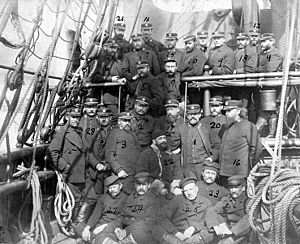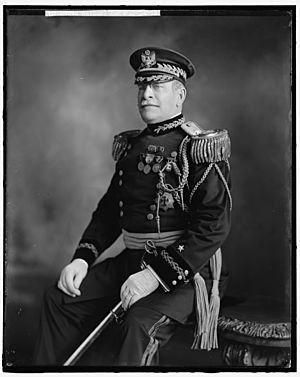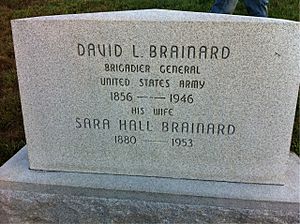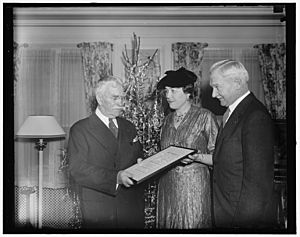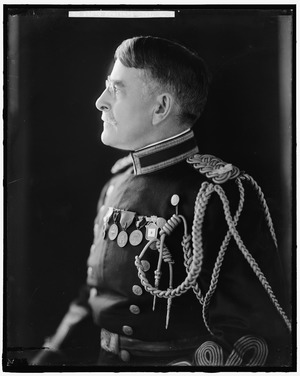David L. Brainard facts for kids
Quick facts for kids
David L. Brainard
|
|
|---|---|
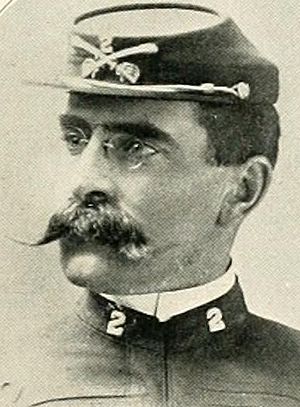
Brainard as a major in 1902
|
|
| Birth name | David Legge Brainard |
| Born | December 21, 1856 Norway, New York, U.S. |
| Died | March 22, 1946 (aged 89) Washington, D.C., U.S. |
| Buried | |
| Allegiance | |
| Branch | United States Army |
| Service years | 1876–1919 |
| Rank | Brigadier General |
| Service number | 0-13116 |
| Commands held | Chief Commissary, Department of the East Chief Commissary, Department of California Chief Commissary, Philippine Division U.S. Military Attaché, Buenos Aires, Argentina U.S. Military Attaché, Lisbon, Portugal |
| Wars | American Indian Wars Spanish–American War Philippine–American War World War I |
| Awards | Purple Heart Military Order of Christ (Grand Officer) (Portugal) Military Order of Aviz (Grand Officer) (Portugal) Legion of Honor (Officer) (France) |
| Alma mater | State Normal School, Cortland, New York |
| Spouse(s) | Anna Chase (m. 1888–1893, div.) Sara Hall Guthrie Neff (m. 1917–1946, his death) |
David Legge Brainard (December 21, 1856 – March 22, 1946) was an important officer in the United States Army. He joined the Army in 1876 and became an officer in 1886. He served until 1919. Brainard reached the high rank of brigadier general. During World War I, he worked as a U.S. military attaché in Lisbon, Portugal.
Brainard was born in Norway, New York. He grew up and went to school there and in nearby Freetown. He graduated from the State Normal School in Cortland, New York.
Besides his service in World War I, Brainard also fought in the American Indian Wars, the Spanish–American War, and the Philippine–American War. He was also a famous arctic explorer. He became well-known as one of only six people who survived the difficult Lady Franklin Bay Expedition from 1881 to 1884. He received several awards for his amazing explorations. He passed away in Washington, D.C., on March 22, 1946, and was buried at Arlington National Cemetery.
Contents
Early Life and Education
David Brainard was born in Norway, New York, on December 21, 1856. He was the fifth son of Alanson and Maria Brainard. When he was ten years old, his family moved to a farm in Freetown, New York.
He grew up and went to school in both Norway and Freetown. He later attended the State Normal School in Cortland, New York. After finishing his education, he decided he wanted to join the military.
A Career in the Army
Starting as a Soldier
Brainard joined the United States Army in September 1876. He was part of the 2nd Cavalry Regiment. He served at Fort Keogh, Montana Territory, during the Great Sioux War of 1876. On May 7, 1877, Brainard fought in the Battle of Little Muddy Creek in Montana. He was injured in his face and right hand during this battle.
In August 1877, Brainard was one of four soldiers chosen for a special job. They escorted the Army's top general, William Tecumseh Sherman, and his group. They were on a trip to inspect Yellowstone National Park. In 1877 and 1878, he served under Nelson A. Miles in Montana. This was during the Nez Perce War and the Bannock War. He was promoted to corporal in October 1877. Then, he became a sergeant in July 1879.
The Dangerous Arctic Expedition
In 1880, Brainard was chosen for an expedition to Greenland. However, a big storm damaged the ship, and the trip had to turn back. In 1881, he was picked to be the first sergeant for the Lady Franklin Bay Expedition. This journey was led by Adolphus Greely. Brainard kept a detailed journal throughout the three years of this expedition.
Twenty-five men started this journey to the Arctic. The expedition faced huge problems when ships meant to bring them supplies failed to arrive. Several rescue attempts also couldn't reach them. Many men died, including James Booth Lockwood. Lockwood was the second-in-command and Brainard's friend. They had explored together, even reaching a record-breaking point far north.
Brainard played a key role in saving lives. He carefully managed the group's very limited food. This helped as many people as possible survive. Just before they were rescued in the spring of 1884, Brainard was freezing, starving, and sick with scurvy. He wrote in his journal that death would be a welcome relief. Brainard was one of only six survivors rescued by Rear Admiral Winfield Scott Schley on June 22. By then, he was so weak he could barely hold a pencil to write.
Later Army Roles
In 1886, Brainard became a second lieutenant in the 2nd Cavalry. This was a special honor for his brave service in the Arctic expedition. He was the only living U.S. Army officer at that time who had been given a commission specifically for such heroic actions.
Brainard was promoted to first lieutenant in August 1893. In 1896, he moved to the Army's supply department and became a captain. In December 1897, he helped with the Yukon Relief Mission. This mission brought emergency food to miners during the Klondike Gold Rush who were running out of supplies.
In May 1898, Brainard was promoted to temporary lieutenant colonel. He served as the chief supply officer for military forces in the Philippines. This was during the Spanish–American War in 1898 and the Philippine–American War in 1899. In May 1900, he became a permanent major. He later served as the chief supply officer for different Army departments. In 1905, Brainard became a permanent lieutenant colonel. He was also a founding member of The Explorers Club and was its president from 1912 to 1913. He was promoted to colonel in June 1912.
In 1914, Brainard was sent to Buenos Aires, Argentina, as a U.S. military attaché. This means he was a military expert working at the U.S. embassy. In October 1917, Brainard was promoted to temporary brigadier general. During World War I, he served as a military attaché in Lisbon, Portugal. He retired as a brigadier general in October 1919.
Family Life
Brainard married Anna Chase in 1888, but they divorced in 1893. In 1917, he married Sara Hall Guthrie. Brainard did not have any children of his own. He was the stepfather to his second wife's daughter, Elinor.
Retirement and Legacy
After leaving the Army, Brainard became the vice president of the Association of Army and Navy Stores. He also joined the association's board of directors. He remained active in these roles until he passed away.
In 1936, on his 80th birthday, he was made an honorary member of the American Polar Society. This was a special recognition for his Arctic explorations.
Brainard died at Walter Reed Army Medical Center in Washington, D.C., on March 22, 1946. He was buried at Arlington National Cemetery. He was the very last person to survive the Greely Arctic Expedition.
Awards and Honors
Military Awards
The Purple Heart medal was created in 1932. On January 27, 1933, Brainard received this award. He earned it for the wounds he got at the Battle of Little Muddy Creek in 1877. His Purple Heart was one of only two known to be given for the American Indian Wars. This is because, at the time, awards were not given after a person died. Also, people had to apply for them themselves.
Brainard received several military awards and decorations, including:
- Purple Heart
- Indian Campaign Medal
- Spanish Campaign Medal
- Philippine Campaign Medal
- World War I Victory Medal
- Military Order of Christ (Grand Officer) (Portugal)
- Military Order of Aviz (Grand Officer) (Portugal)
- Legion of Honor (Officer) (France)
Civilian Honors
Besides his military awards, Brainard also received special honors for his explorations. In 1886, he received the Royal Geographical Society's Back Award. He was also a member of the American Geographical Society. For his Arctic explorations, he was given the society's Charles P. Daly Medal in 1926. In 1929, he also received the civilian Explorers Club Medal.


